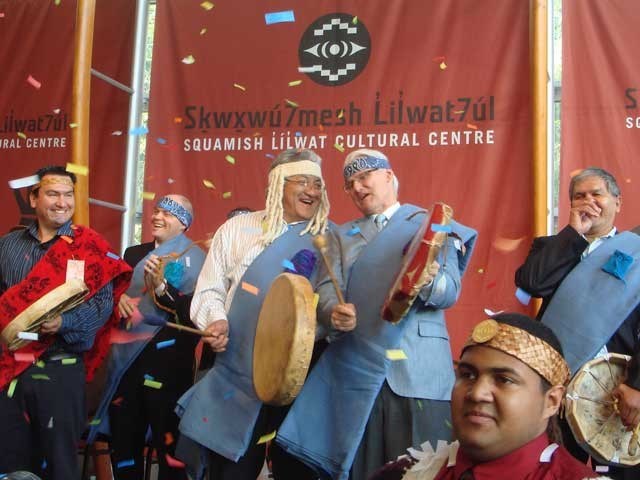It’s been over a decade in the making, but for the Squamish and Lil’wat peoples of the Sea to Sky corridor, it was a longer time coming.
Either way you look at it, the Squamish Lil’wat Cultural Centre
is now officially open and ready to stand as a lasting monument for the people
born of the Sea to Sky lands.
“We are in a special place in British Columbia,” Premier Gordon Campbell said at the opening.
“We’re in a place that will build education and understanding between the Lil’wat, the Squamish and First Nations in British Columbia generally, and the rest of the province, and we’re in a place that will be a very special place as we host the world in 2010.”
The grand opening took place on the morning of July 10, and in many ways it was an unconventional one. Many dignitaries were present, including Campbell and MP James Moore, who is Secretary of State for Asia-Pacific Gateway and the 2010 Olympics. Jack Poole, chair of VANOC, also attended.
They joined the chiefs of the Squamish and Lil’wat Nations atop
a stage where they exchanged a series of praises and congratulations for
bringing the cultural centre to life.
The ceremony began with Squamish hereditary Chief Ian Campbell
and Lyle Leo from the Lil’wat Nation asking a series of people to act as
witnesses. It is Squamish tradition to have witnesses for historical events.
Premier Campbell was the first dignitary to speak.
“Today (the centre) is a bridge to the future of British
Columbia,” he said. “Look above you, and you see the canoes that are part of
our First Nations’ culture. Look at the walls and you see the great panels of
wood that help shape our province.
“As long as these great forests grow around us, and the great
streams run around us on the ground, this will be the traditional territories
of the Squamish and the Lil’wat Nation. This will be a part of British
Columbia, and this will be a part of Canada’s future.”
Moore, speaking on behalf of Prime Minister Stephen Harper,
said the centre will make Whistler a new type of travel destination.
“You’ve succeeded in creating a must-see destination and to
stand out in a place such as Whistler is truly a remarkable achievement,” he
said. “This centre will proudly showcase your culture and values to the world,
and as a growing demand for travel experiences that include authentic local
cultures, vivid oral histories will be shared with thousands.”
Squamish Chief Gibby Jacob, meanwhile, said the centre could
help represent a cultural revival for the Squamish people.
“This is a lifelong dream for some and a shorter dream for
others,” he said. “If we are not doing things that are positive and good for
our people, the opposite exists. The status quo is not acceptable, it hasn’t
been and it never will be.”
Lil’wat Chief Leonard Andrew offered thanks to several people,
notably the builders themselves and former Lil’wat Chief Allan Stager for
helping to bring the centre to fruition.
“First of all, I just want to say, welcome to our land, welcome
to our house,” he said. “This great venue, is now open to the public, and a lot
of people are already phoning me and very likely phoning others and saying it’s
a magnificent building.”
The speeches were followed by the playing of a Squamish “bear
song.” Premier Campbell was given a drum and asked to play alongside Chief
Jacob atop the stage.
The genesis of the Squamish Lil’wat Cultural Centre has been
dated as early as 1997, when the Resort Municipality of Whistler met with the
Lil’wat Nation to discuss how better to incorporate the Nation’s presence into
Whistler. Out of those discussions came the idea for a “world-class” cultural centre,
according to the cultural centre’s website.
The Lil’wat and Squamish Nations later met to discuss land use
in places where their territories overlap. The nations signed a Protocol
Agreement that committed them to co-operating on matters of cultural and
economic development.
Many at the opening noted that the centre would be a prime
destination for tourists coming to Whistler during the 2010 Games.
Jack Poole noted that the partnership between VANOC and the Four Host First Nations, which includes the Squamish, Lil’wat, Musqueam and Tsleil-Waututh peoples, is the first of its kind in Olympic history.




